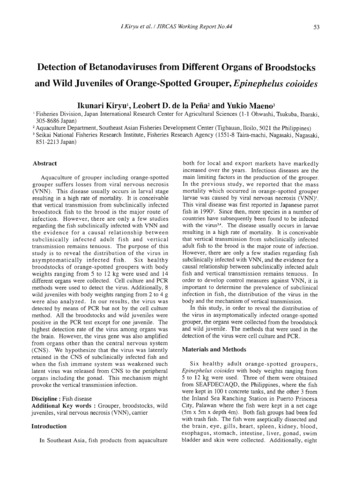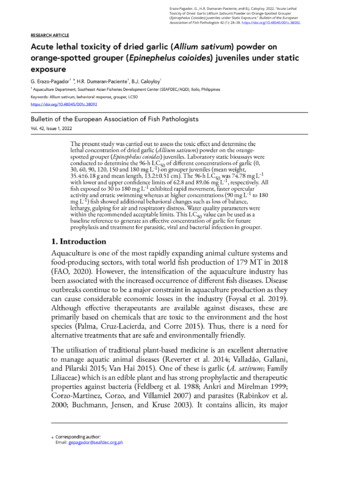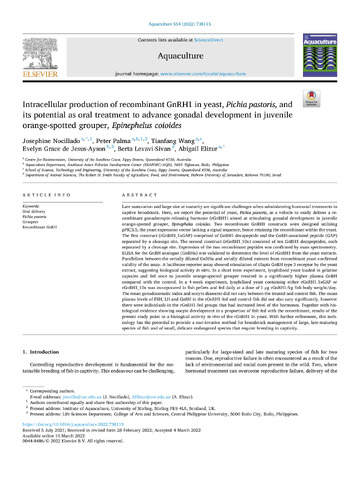Detection of betanodaviruses from different organs of broodstocks and wild juveniles of orange-spotted grouper, Epinephelus coioides
Share
Abstract
Aquaculture of grouper including orange-spotted grouper suffers losses from viral nervous necrosis (VNN). This disease usually occurs in larval stage resulting in a high rate of mortality. It is conceivable that vertical transmission from subclinically infected broodstock fish to the brood is the major route of infection. However, there are only a few studies regarding the fish subclinically infected with VNN and the evidence for a causal relationship between subclinically infected adult fish and vertical transmission remains tenuous. The purpose of this study is to reveal the distribution of the virus in asymptomatically infected fish. Six healthy broodstocks of orange-spotted groupers with body weights ranging from 5 to 12 kg were used and 14 different organs were collected. Cell culture and PCR methods were used to detect the virus. Additionally, 8 wild juveniles with body weights ranging from 2 to 4 g were also analyzed. In our results, the virus was detected by means of PCR but not by the cell culture method. All the broodstocks and wild juveniles were positive in the PCR test except for one juvenile. The highest detection rate of the virus among organs was the brain. However, the virus gene was also amplified from organs other than the central nervous system (CNS). We hypothesize that the virus was latently retained in the CNS of subclinically infected fish and when the fish immune system was weakened such latent virus was released from CNS to the peripheral organs including the gonad. This mechanism might provoke the vertical transmission infection.
Subject
Taxonomic term
Collections
Related items
Showing items related by title, author, creator and subject.
-
Acute lethal toxicity of dried garlic (Allium sativum) powder on orange-spotted grouper (Epinephelus coioides) juveniles under static exposure
Erazo-Pagador, Gregoria; Dumaran-Paciente, Haydee Rose; Caloyloy, Blan Jericho (European Association of Fish Pathologists, 2022-10-05)The present study was carried out to assess the toxic effect and determine the lethal concentration of dried garlic (Allium sativum) powder on the orange-spotted grouper (Epinephelus coioides) juveniles. ... -
Intracellular production of recombinant GnRH1 in yeast, Pichia pastoris, and its potential as oral treatment to advance gonadal development in juvenile orange-spotted grouper, Epinephelus coioides
Nocillado, Josephine; Palma, Peter; Wang, Tianfang; de Jesus-Ayson, Evelyn Grace T.; Levavi-Sivan, Berta; Elizur, Abigail (Elsevier, 2022-05)Late maturation and large size at maturity are significant challenges when administering hormonal treatments in captive broodstock. Here, we report the potential of yeast, Pichia pastoris, as a vehicle to orally deliver a ... -
Changes in Na+, K+-ATPase activity and gill chloride cell morphology in the grouper Epinephelus coioides larvae and juveniles in response to salinity and temperature
Caberoy, N. B.; Quinitio, G. F. (Springer Verlag, 2000)The activity of the enzyme Na+, K+-ATPase and morphological changes of gill chloride cells in grouper, Epinephelus coioides larvae and juveniles were determined 6–48 h after abrupt transfer from ambient ...






